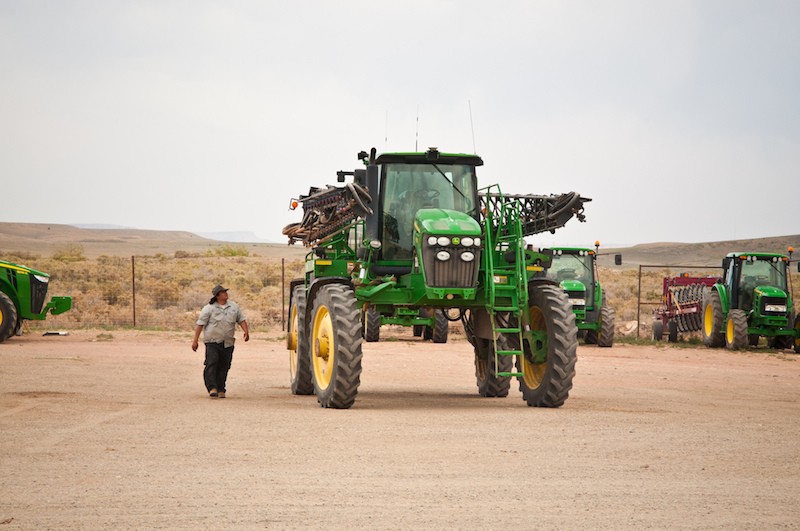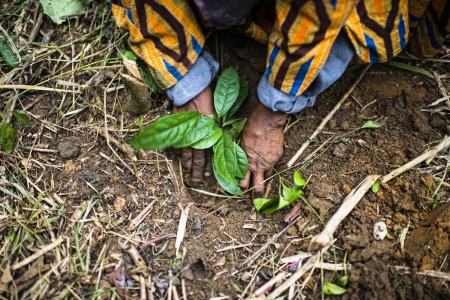This post is written in response to: Sustainable intensification of agriculture: oxymoron or real deal?
Most evidence points to conventional, intensive farming as a better option for the environment than more extensive or organic systems, and it has been getting better over time.
Few other human activities have caused so much environmental harm as agriculture in the last half century. Farming is major contributor to habitat loss, greenhouse gas emissions, and eutrophication, as well as freshwater depletion and soil erosion. Against this background of increasing environmental impacts from food production, calls are being made to shift to an alternative paradigm: sustainable intensification.
Sustainable, that is, in contrast to the assumed unsustainability of today’s farming, dominated by intensive, industrial systems. But in terms of environmental impacts per unit of food produced - the fairest way to evaluate farming itself, separate from trends in population or diets - agriculture has for the most part gotten better, not worse, over time.

Intensification reduces habitat loss
The most devastating impact of food production on the natural world is the habitat loss that results from expanding farmland area. The way farmers can mitigate this, given a certain level of food demand, is by producing more food on less land. In this respect, intensification over the last few decades has been an enormous success.
Farmers today produce three times as much crops using only 13% more land than about 50 years ago. The area of pasture has gone up by only 9% in the same time period. In fact, the global farmland area has remained stable since the mid 1990s, in spite of the global population growing by more than 20% and GDP per capita nearly doubling.
Granted, intensification has also caused loss of biodiversity on existing farmland. Populations of many European farmland birds, for instance, have declined markedly. Yet at a global level, it is likely that more biodiversity has been saved by avoided area expansion, than has been lost on farmland as a result of intensification. In this sense, global yield improvements have been a boon for the environment.
High input systems yield net positive for the environment
These yield improvements would not have been possible without vastly increased energy inputs in the form of synthetic fertilizers, pesticides, irrigation, and machinery. Most of this energy has come from fossil fuels, thus contributing to climate change.
Modern farming actually uses more energy per unit of crop output than traditional systems. Yet the increasing amounts of carbon emitted from farming operations has been more than offset by the greenhouse gas emissions that have been saved through avoided deforestation. For this reason, intensification has led to lower net greenhouse gas emissions compared to a scenario without intensification, according to a study by Jennifer Burney et al.
When it comes to fertilizers and the harm they cause through eutrophication and coastal dead zones, the picture is more mixed at a global level. At early stages of their development, countries tend to apply nitrogen fertilizer very liberally, leading to more pollution. But beyond a certain point, countries have historically curbed this trend, and moved towards increasingly nitrogen-efficient farming.
The amount of nitrogen pollution per unit of crop output in the United States peaked in the early 1970s, and has declined by about one-third since then. Similar trends have been observed across other developed regions, including Europe. What is more, richer countries with higher yields consistently cause less nitrogen pollution per unit output than regions with lower yields. Crop yields in OECD countries are 70% higher than in non-OECD countries, with only 54% greater nitrogen inputs.
There is also evidence to suggest that higher-yield systems cause less soil erosion than low-yield systems, at a global level. One study estimated that rates of soil loss are more than twice as high in developing countries than in developed countries. This may be due to the fact that farming often takes place on more marginal land in developing countries, and the increasing adoption of conservation and no-till methods in developed regions.
In terms of meat production, intensive systems on average tend to have lower environmental impacts per unit of output than their less productive counterparts. The most productive livestock system in North America uses twenty times less land than the most productive system in Sub-Saharan Africa to produce the same amount of beef.
Feedlot systems in the United States use 45% less land, and have 51% lower nitrogen and phosphorous emissions and 40% lower greenhouse gas emissions per unit of beef than grass-fed systems. Meat production has also become more efficient, and thus less damaging to the environment, over time. For instance, the amount of feed required to produce a pound of beef in the US declined by 19% between 1977 and 2007.
Conventional farming gets better over time
Even when comparing conventional with organic farming within developed countries, the more intensive, conventional systems are often superior from an environmental perspective. Organic farming on average requires at least 20% more land to produce a given amount of food, while generating similar or higher levels of nitrogen pollution. As organic farming scales up, it appears to lose its advantage over conventional farming in terms of greenhouse gas emissions.
In sum, most evidence points to conventional, intensive farming as a better option for the environment than more extensive or organic systems, and it has been getting better over time.
But it is far from perfect. To accelerate the positive trends that have been emerging, precision farming should be spread more widely in developed countries, so that fertilizer, pesticides, and water inputs can be minimized in relation to yields. It also means spreading modern agricultural technologies like fertilizers, irrigation, and machinery in developing countries, so that their yields can keep pace with population growth and changing diets. Along with intensification, landscape-level conservation planning can help ensure that agricultural production takes place, as far as possible, on already cleared land, and that the most biologically rich areas are protected.
Industrial farming will not be appropriate in every context. Communities may choose to dedicate some of their land to organic practices, or farming methods that preserve a cultural landscape. In some regions, less intensive farming supports threatened species of birds and other wildlife. There will continue to exist demand for grass-fed beef.
Yet on a planet of seven going on nine or ten billion increasingly wealthy people, producing more food while minimizing environmental impacts will for the most part be a story of refining, rather than abandoning, industrial farming.
Let us know what you think of the Ecomodernist Manifesto in the comments section below.
Read more
-
Download the newly released Ecomodernist Manifesto
-
Read a recent review of the manifesto on the Guardian
-
A Thrive Debate: Organic versus non-organic agriculture

















Comments
Comparing organic and conventional farming is a challenge as silly as the one comparing geocentric and heliocentric models. Trying to understand one model makes the other model counter-intuitive. This is because the two models are just possible like geocentrism and heliocentrism... however one is less possible than the other. The one which puts life in a corner while beleiving on human hubris is clearly of the same type than geo-centrism.
Ecomodernism is just a positivism
Conventional farming has been proven to not work. Most conventional farming only has profit in mind. Not human nor planet health. Synthetic fertilizers and pesticides are kilinling our soil and insects. Both of which are necessary if we want to continue the survival of the human race. I have read that scientists have concluded that we only have about 60 more plantings seasons left. Then, our soils will be dead. Then what will big ag do? I'll tell you what they'll do. With the help of our criminal government, they will start confiscating the private land of citizens. Telling the people they have no choice if we are to survive. But it will have nothing to do with survival. Just profit. Because they will sell back to the people, product grown on stolen land, at a highly inflated price (because stealing land doesn't come cheap ) all the while telling them what a huge service government and big ag are doing for them. When all the while, all they had to do is develop sustainable farming practices composting, organic fertilization and pest control, crop rotation. But no, those practices erode profit. It's just easier to farm the farms into the dirt ( pun intended ) then steal what we need from the people under the false pretense of an economic and agricultural emergency. It's time to get big ag out of government. Our lives (and property ) depend on it.
A. Lincoln saw agriculture as an opportunity for "cultivated thought," saying, "Every blade of grass is a study; and to produce two, where there was but one, is both a profit and a pleasure." Making a profit is not the problem it is not recognizing the harm to our resource or our neighbors the production process used may cause. This approach to use our best lands, suited for the intended use and already in production to produce more is not bad, provided the process is managed to do no harm. It would best to do this with use of organic methods as crop rotations, reduce dependence on fertilizer and other inputs. If intensification however can allow marginal lands to be put to uses better suited then there would be less dependence on outside inputs, less runoff and erosion. The time, labor and capital spent on low returns from the marginal land could then be better used by intensification of the suited land. Another quote I can not attribute to Lincoln is our misinterpretation of progress. "Change is too often misinterpreted as progress. Progress must start in the hearts of men". If we are to have true change it must be in the heart of the farmer, that he is producing food for humanity and at the same time is a steward of the land.
For me there are three variables to juggle.
1. Demand (changing what and how much we eat, moving towards healthier diets)
2. Efficiency of production (improved soils, higher yielding varieties, lower environmental impact etc.)
3. Land sparing (I hope and expect that the above will lead to reduced land requirement).
The driving force for decision making regarding points 1 and 2 should be to consider their interactions and how they will lead to land sparing.
The key remaining question being what would we do with this spared land?
1. Build houses?
2. Plant trees?
3. Use it as a fail-safe if the increasing population can't always be fed?
These are important policy questions that so far have been answered by very local and short-term decision making. A change is needed.
Add new comment